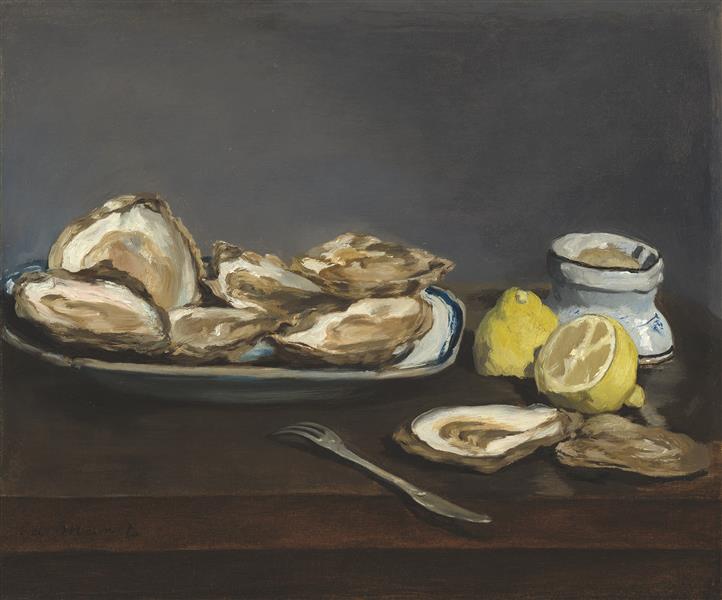Description
In 1862, Édouard Manet, one of the pioneers of modernism in painting, offers us in his work "Oysters" a profound study of realism through the representation of a seemingly simple subject: a plate of oysters. Encapsulating both Manet's technical mastery and his keen observation of everyday life, this work breaks away from the academic conventions of the time and reflects his distinctive vision of the world around him.
The composition of “Oysters” is remarkable for its simplicity and elegance. The painting is an intimate portrait of an aspect of 19th-century bourgeois life, revealing the hedonistic pleasure associated with gastronomy and, at the same time, an air of sophistication and luxury. At the centre of the work, an object of obvious desire, the plate full of oysters, is presented in an almost monumental manner. Manet makes use of a subtle colour palette, where grey tones, whites and blue shades dominate, providing a sense of freshness. He also employs contrasts that reinforce the three-dimensionality of the oysters and their shape, giving life to an element that is both food and a symbol of indulgence.
The visual details are equally captivating. The surface of the plate glistens under a soft light, creating an almost luminous effect that accentuates the oysters’ appeal. Each shell is precisely rendered, and the play of light and shadow on them reveals a careful attention to texture that Manet manages to capture. In this sense, his approach goes beyond the merely representative, inviting the viewer to perceive not only the form, but also the essence of the oysters: the freshness of the sea, the wildness and sensuality.
The painting does not include human figures, but its social implication is palpable. The choice of a plate of oysters as a subject reflects the culinary trends and rituals of high society at the time, suggesting the context of a banquet or social gathering. It is a work that allows the audience to imagine the dining experience and the interaction that surrounds it. In this sense, Manet does not simply capture a moment; he creates a narrative that evokes the rich traditions of the art of the table.
In the context of Manet's work, "Oysters" can be seen as a manifestation of his interest in modernity and contemporary life. As a precursor of Impressionism, Manet focused on themes beyond the mythological and historical, approaching everyday life with a fresh and critical eye. Other works by Manet, such as "Breakfast on the Grass" and "Olympia", also share this connection with modernity and the challenging approach to nudism and the female figure in contemporary contexts.
Manet, throughout his career, was known for questioning the established norms of painting. In "Oysters", this same essence is present, although in a more subtle form. Through the representation of a food considered a luxury, he invites us to reflect on the values of the society of his time, the seduction of ostentation and the search for pleasure.
In conclusion, “Oysters” is not just a painting of a plate; it is an invitation to explore the pleasures of life and the complexity of social interactions, all in a work that captures Édouard Manet’s technical mastery and innovative vision. Through this work, the viewer not only observes, but also becomes involved in the narrative that the painter himself has woven, connecting aesthetics with the social context of the moment, a characteristic that continues to resonate in contemporary art.
KUADROS ©, a famous painting on your wall.
Hand-made oil painting reproductions, with the quality of professional artists and the distinctive seal of KUADROS ©.
Painting reproduction service with satisfaction guarantee. If you are not completely satisfied with the replica of your painting, we will refund 100% of your money.

